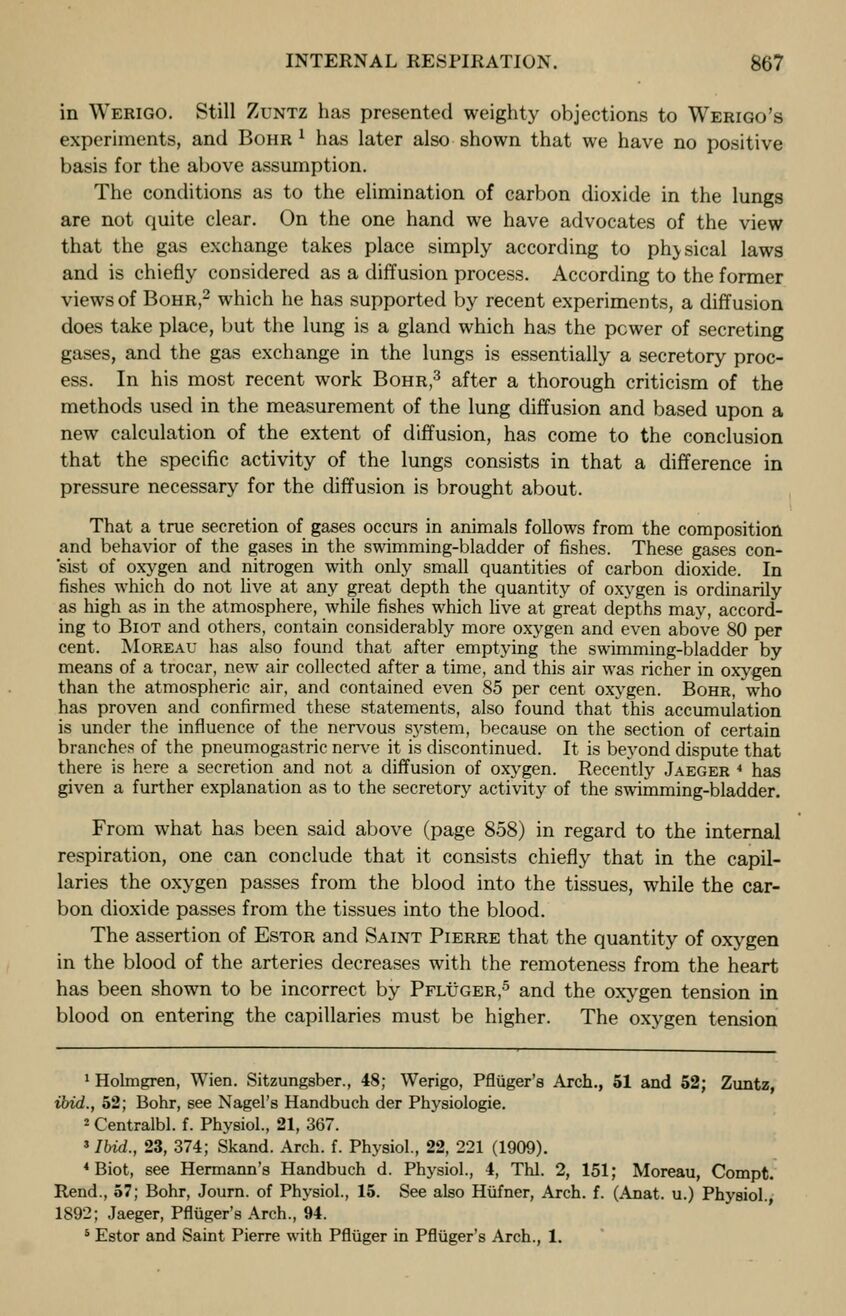
Full resolution (JPEG) - On this page / på denna sida - XVI. Respiration and Oxidation - II. The Exchange of Gas between the Blood, on the one hand, and Pulmonary Air and the Tissues, on the other

<< prev. page << föreg. sida << >> nästa sida >> next page >>
Below is the raw OCR text
from the above scanned image.
Do you see an error? Proofread the page now!
Här nedan syns maskintolkade texten från faksimilbilden ovan.
Ser du något fel? Korrekturläs sidan nu!
This page has never been proofread. / Denna sida har aldrig korrekturlästs.
INTERNAL RESPIRATION. 867
in Werigo. Still Zuntz has presented weighty objections to Werigo’s
experiments, and Bohr 1
has later also shown that we have no positive
basis for the above assumption.
The conditions as to the elimination of carbon dioxide in the lungs
are not quite clear. On the one hand we have advocates of the view
that the gas exchange takes place simply according to physical laws
and is chiefly considered as a diffusion process. According to the former
views of Bohr,2 which he has supported by recent experiments, a diffusion
does take place, but the lung is a gland which has the power of secreting
gases, and the gas exchange in the lungs is essentially a secretory proc-
ess. In his most recent work Bohr,3
after a thorough criticism of the
methods used in the measurement of the lung diffusion and based upon a
new calculation of the extent of diffusion, has come to the conclusion
that the specific activity of the lungs consists in that a difference in
pressure necessary for the diffusion is brought about.
That a true secretion of gases occurs in animals follows from the composition
and behavior of the gases in the swimming-bladder of fishes. These gases con-
sist of oxygen and nitrogen with only small quantities of carbon dioxide. In
fishes which do not live at any great depth the quantity of oxygen is ordinarily
as high as in the atmosphere, while fishes which live at great depths may, accord-
ing to Biot and others, contain considerably more oxygen and even above 80 per
cent. AIoreau has also found that after emptying the swimming-bladder by
means of a trocar, new air collected after a time, and this air was richer in oxygen
than the atmospheric air, and contained even 85 per cent oxygen. Bohr, "who
has proven and confirmed these statements, also found that this accumulation
is under the influence of the nervous system, because on the section of certain
branches of the pneumogastric nerve it is discontinued. It is beyond dispute that
there is here a secretion and not a diffusion of oxygen. Recently Jaeger *
has
given a further explanation as to the secretory activity of the swimming-bladder.
From what has been said above (page 858) in regard to the internal
respiration, one can conclude that it consists chiefly that in the capil-
laries the oxygen passes from the blood into the tissues, while the car-
bon dioxide passes from the tissues into the blood.
The assertion of Estor and Saint Pierre that the quantity of oxygen
in the blood of the arteries decreases with the remoteness from the heart
has been shown to be incorrect by Pfluger,5
and the oxygen tension in
blood on entering the capillaries must be higher. The oxygen tension
1
Holmgren, Wien. Sitzungsber., 48; Werigo, Pfliiger’s Arch., 51 and 52; Zuntz,
ibid., 52; Bohr, see Nagel’s Handbuch der Physiologic
2
Centralbl. f. Physiol., 21, 367.
3
Ibid., 23, 374; Skand. Arch. f. Physiol., 22, 221 (1909).
4
Biot, see Hermann’s Handbuch d. Physiol., 4, Thl. 2, 151; Moreau, Compt.
Rend., 57; Bohr, Journ. of Physiol., 15. See also Hiifner, Arch. f. (Anat. u.) Physiol.
1892; Jaeger, Pfluger’s Arch., 94.
5
Estor and Saint Pierre with Pfluger in Pfliiger’s Arch., 1.
<< prev. page << föreg. sida << >> nästa sida >> next page >>